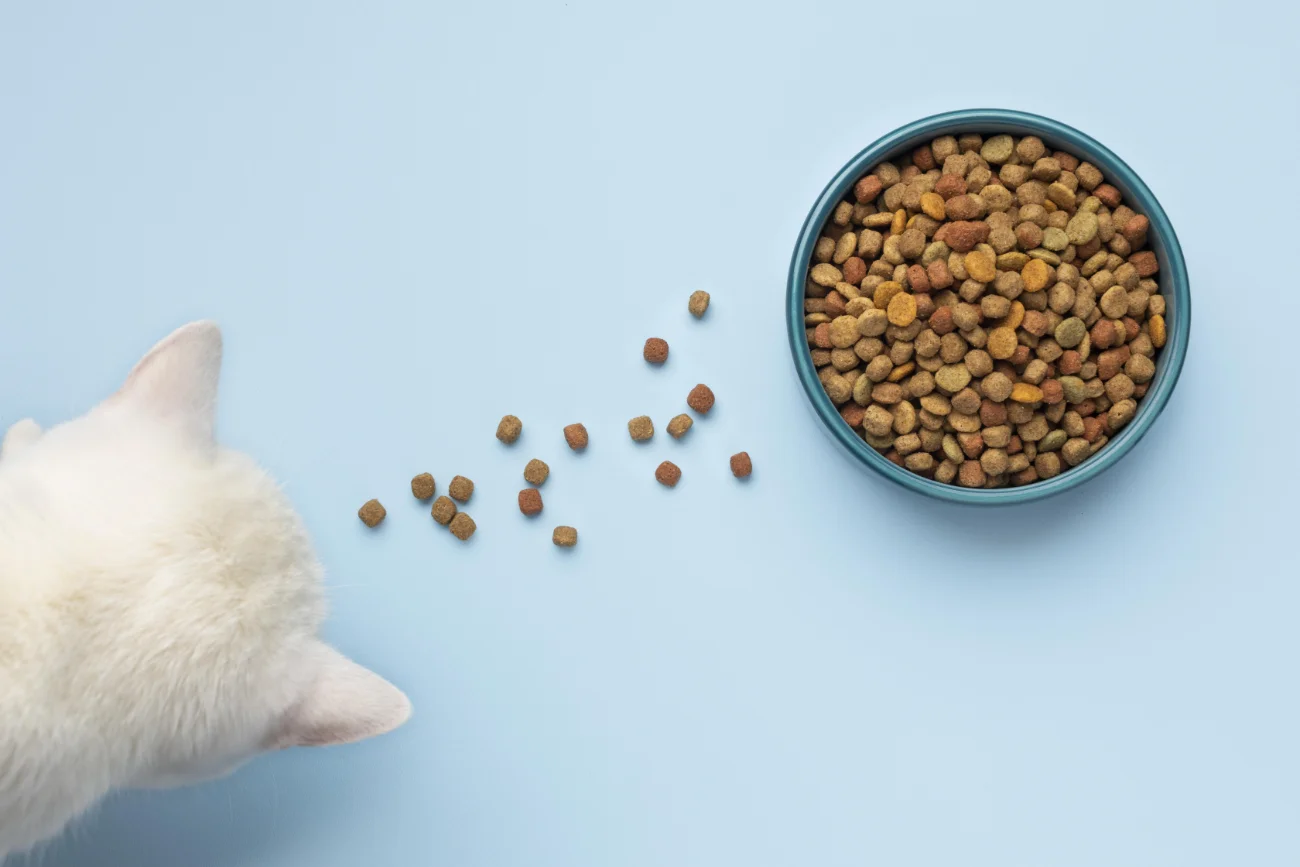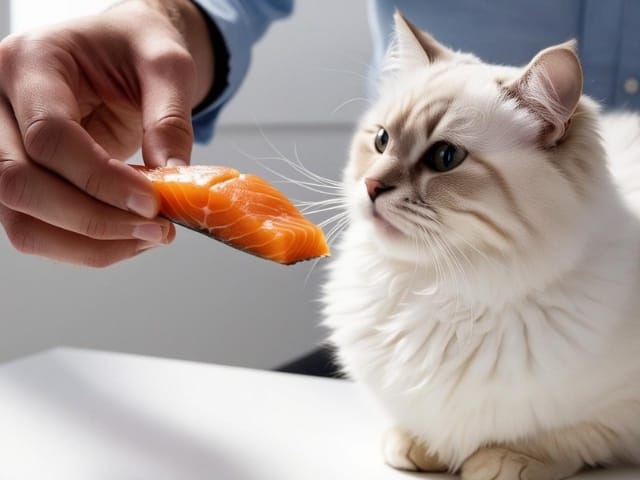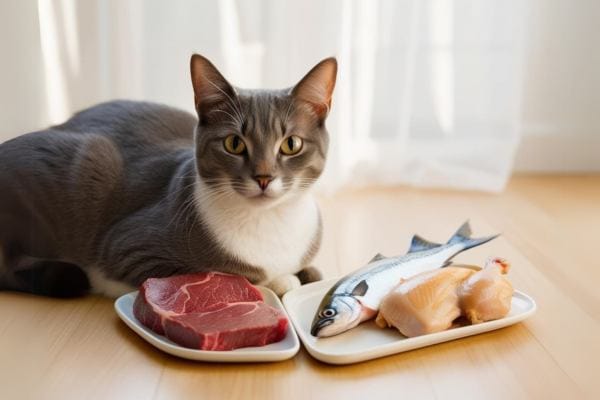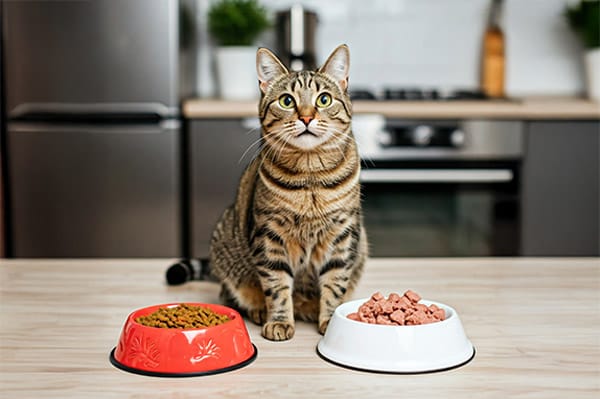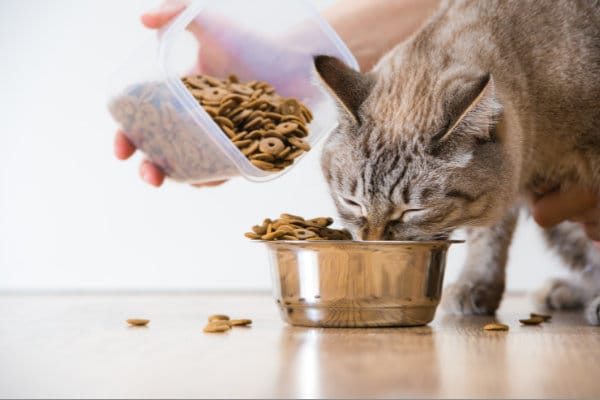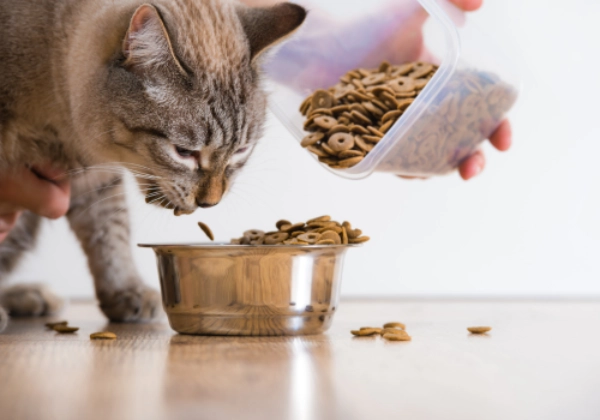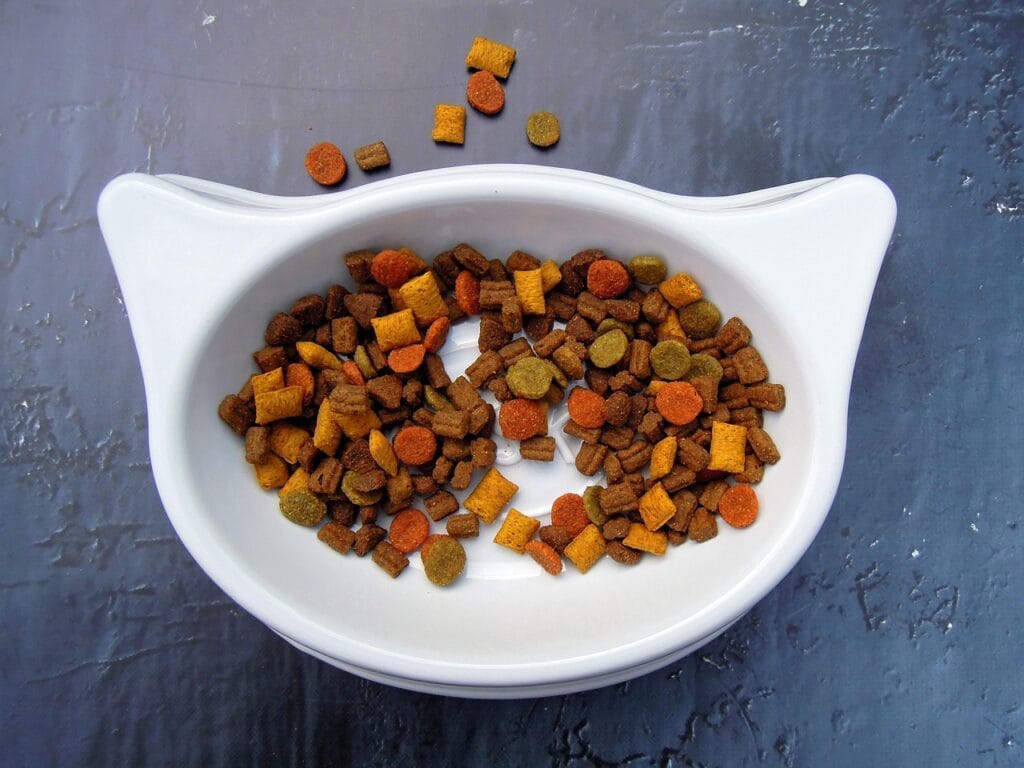
We may earn a commission when you purchase via our links at no extra cost to you.
We only share resources that meet our high standards
Introduction
Navigating the debate over grain-free cat food vs grain-inclusive options can be confusing. As a cat owner, you know that the food you choose directly affects your pet’s health, energy, and well-being. Before you decide to switch or stick with your current routine, it’s important to understand the pros and cons of both diets. Let’s explore the key differences to help you make an informed decision.
The Nutritional Basics of Cat Diets
Cats evolved as obligate carnivores, requiring specific nutrients found primarily in animal proteins. Your feline companion needs a diet rich in taurine, arachidonic acid, and animal-based proteins – nutrients that their bodies can’t produce independently. A balanced cat diet typically consists of 52% protein, 36% fat, and 12% carbohydrates, closely mimicking what they would consume in the wild.
The Role of Grains in Feline Nutrition
Grains in cat food serve as a source of energy, fiber, and crucial nutrients like B vitamins and minerals. Your cat’s digestive system can process moderate amounts of properly cooked grains, though they lack the enzymatic equipment to efficiently digest large quantities. Quality grains like brown rice and oats can provide sustainable energy when included as a secondary ingredient rather than a primary protein source.
Grain-Free Alternatives: What’s on the Plate?
Grain-free diets replace traditional grains with alternative carbohydrate sources such as sweet potatoes, peas, and lentils. These ingredients provide similar energy levels while potentially offering higher protein content and fewer allergenic properties. Your cat’s grain-free options typically feature increased meat content and fewer plant-based ingredients overall.
Modern grain-free formulations incorporate novel proteins like rabbit, duck, or venison, paired with nutrient-rich vegetables and legumes. These alternatives often contain higher levels of omega-3 fatty acids and antioxidants from sources like cranberries and blueberries. You’ll find that many grain-free options also include supplemental taurine and probiotics to support your cat’s overall health and digestion.
Crunching the Numbers: Nutritional Profiles and Ingredients
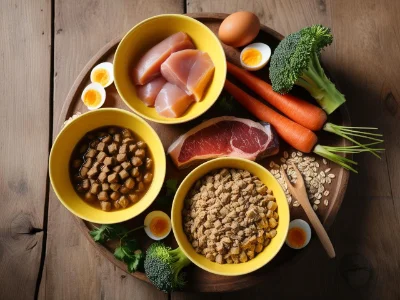
Analyzing the nutritional content reveals distinct differences between grain-free and grain-inclusive formulas. While grain-free options typically contain 28-44% protein and 15-20% fat, grain-inclusive varieties average 25-35% protein and 12-18% fat. These variations directly impact your cat’s daily nutrient intake and energy levels.
Comparing Protein Sources: Animal vs. Plant-Based
| Animal-Based | Plant-Based |
|---|---|
| Higher biological value | Lower biological value |
| Complete amino acid profile | Incomplete amino acid profile |
| Better digestibility (90-95%) | Lower digestibility (75-85%) |
The Role of Carbohydrates in Feline Diets
Cats metabolize carbohydrates differently than humans or dogs, converting them primarily into fat storage rather than immediate energy. Your cat’s natural diet would contain only 1-2% carbohydrates in the wild, yet commercial grain-inclusive foods often contain 30-40% carbohydrates.
Research shows that cats can efficiently process up to 40% carbohydrates in their diet, though they don’t require them for survival. The type of carbohydrate matters more than quantity – complex carbohydrates from sources like sweet potatoes or peas provide more sustained energy than simple carbohydrates from grains. Your cat’s age, activity level, and health conditions should guide your carbohydrate choices. Also check our complete cat nutrition guide here: Complete Cat Nutrition Guide
The Great Debate: Benefits of Grain-Free Cat Food
Grain-free diets offer several advantages that align with cats’ natural dietary needs as obligate carnivores. These formulations typically contain higher protein content from quality meat sources, mimicking the prey-based diet cats would consume in the wild. The absence of grains makes room for more protein-rich ingredients, potentially offering better nutrient absorption and digestibility for your feline companion.
Potential Health Improvements: Allergies and Sensitivities
Cats experiencing food sensitivities often show remarkable improvement on grain-free diets. Signs like excessive scratching, digestive issues, and skin problems may decrease significantly when you eliminate grains from your cat’s diet. While true grain allergies are relatively rare in cats, affecting only 1-2% of the population, some cats simply digest meat-based proteins more efficiently than grain-based ingredients.
The Weight Loss Angle: Leaner Cats, Healthier Lives
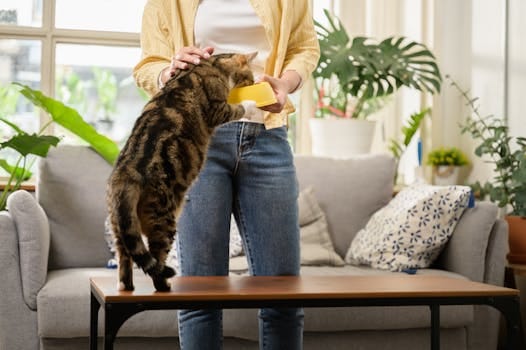
Grain-free formulas generally contain fewer carbohydrates and more protein, helping your cat maintain a healthy weight. The higher protein content promotes lean muscle mass while keeping your cat feeling satisfied longer, reducing the likelihood of overeating. Many veterinarians report seeing positive weight management results in overweight cats switched to grain-free diets.
Studies show cats on grain-free diets typically consume 10-15% fewer calories while maintaining the same energy levels. The protein-rich composition triggers better metabolic responses, leading to more efficient fat burning. Your cat’s natural hunting instincts align well with these protein-focused meals, often resulting in more active behavior and improved muscle tone. Monitoring portion sizes remains necessary, as grain-free foods can be more calorie-dense than traditional options.
Health Implications: The Good, The Bad, and The Ugly
The health effects of grain-free versus grain-inclusive diets extend far beyond basic nutrition. Recent studies from veterinary institutions highlight connections between dietary choices and various health conditions in cats. The FDA’s investigation into grain-free diets and heart health has sparked renewed interest in understanding these relationships, while long-term research continues to reveal nuanced impacts on feline wellness.
Grain-Free: Potential Benefits for Allergies and Sensitivities
Cats experiencing food sensitivities often show improvement on grain-free diets. Clinical observations indicate reduced skin irritation, decreased digestive issues, and improved coat quality in cats with specific grain allergies. However, true grain allergies affect only 1-3% of cats, making this benefit relevant to a small portion of the feline population. Your cat’s specific allergy profile, confirmed through veterinary testing, should guide this dietary choice.
Grain-Inclusive: Addressing Gastrointestinal Health and Long-Term Effects
Grain-inclusive diets provide beneficial fiber sources that support healthy digestion and regular bowel movements. Studies show that cats on balanced grain-inclusive diets maintain stable blood sugar levels and experience fewer instances of inflammatory bowel disease. The complex carbohydrates in whole grains contribute to sustained energy release and help maintain healthy gut bacteria populations.
Research from the Journal of Feline Medicine and Surgery demonstrates that cats fed grain-inclusive diets show lower incidences of taurine deficiency compared to those on grain-free formulations. Additionally, the presence of specific grains like rice and barley provides prebiotic benefits, supporting your cat’s digestive microbiome. These findings suggest that moderate grain inclusion might offer protective effects against certain metabolic disorders commonly seen in domestic cats.
The Case for Grain-Inclusive Diets: Not All Grains Are Bad
Quality grains in cat food serve multiple purposes beyond simple fillers. Properly processed whole grains provide crucial nutrients, including B vitamins, fiber, and minerals that support your cat’s digestive health and overall wellbeing. Research from veterinary nutritionists shows that cats can effectively digest and utilize nutrients from grains, contrary to popular misconceptions about cats being obligate carnivores.
Understanding Whole Grains and Their Benefits
Whole grains like brown rice, oats, and barley contain valuable nutrients your cat needs. These grains provide complex carbohydrates for sustained energy, fiber for digestive health, and crucial amino acids that complement protein sources. Studies have shown that cats actually possess the enzymatic capability to break down and absorb nutrients from properly processed grains, making them a viable component of a balanced diet.
Balancing Nutrients: Protein, Carbs, and Fats
A well-formulated grain-inclusive diet maintains the right balance of nutrients while keeping costs manageable. Quality grain-inclusive foods typically contain 30-40% protein, 10-20% fat, and moderate carbohydrate levels from whole grain sources. This balance helps maintain healthy blood sugar levels and provides steady energy throughout the day.
Your cat’s nutritional needs can be met through carefully balanced grain-inclusive formulas that prioritize high-quality protein sources while incorporating beneficial whole grains. The Association of American Feed Control Officials (AAFCO) guidelines suggest that adult cats need a minimum of 26% protein in their diet, which many grain-inclusive foods exceed while providing the added benefits of complex carbohydrates and fiber. These formulations often achieve optimal protein-to-fat ratios while keeping calories at appropriate levels for weight management.
The Price Factor: Costs of Grain-Free vs. Grain-Inclusive Options
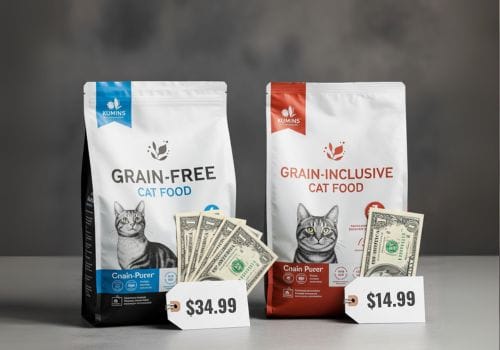
Grain-free cat foods typically cost 20-40% more than their grain-inclusive counterparts. A 12-pound bag of grain-free cat food averages $35-45, while traditional grain-inclusive options range from $25-35. This price difference stems from the higher cost of protein-rich ingredients like meat, fish, and legumes used to replace grains.
Budgeting for Premium Ingredients: Is Grain-Free Worth It?
Your monthly feeding costs can increase by $15-25 when switching to grain-free options. Premium protein sources like duck, venison, or wild-caught fish drive up the price, while grain-inclusive foods use more economical ingredients like corn and rice. Consider your cat’s specific dietary needs and your budget constraints – some cats thrive equally well on high-quality grain-inclusive formulas at a lower cost.
Long-Term Value: Evaluating Health Outcomes Relating to Cost
The potential reduction in veterinary bills could offset the higher upfront costs of grain-free food. Cats with grain sensitivities often show improved digestion, fewer allergic reactions, and better coat quality on grain-free diets, potentially reducing health-related expenses by $200-400 annually.
Your cat’s individual health profile plays a major role in determining long-term value. Grain-free diets might reduce inflammation and digestive issues in sensitive cats, leading to fewer vet visits. However, cats without grain sensitivities may not see significant health improvements to justify the premium price. Track your cat’s health markers, energy levels, and coat condition over 3-6 months to evaluate if the investment delivers tangible benefits.
Grain-Free Cat Food Recommendation
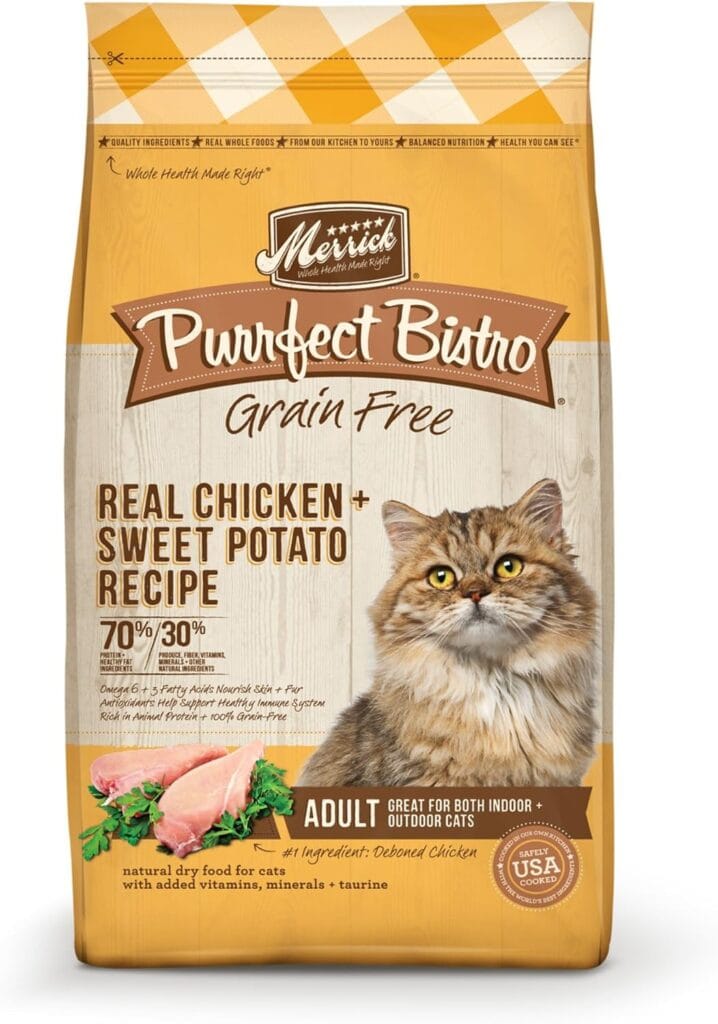
Merrick Purrfect Bistro Grain Free Natural Dry Cat Food For Adult Cats

Blue Buffalo Wilderness Nature’s Evolutionary Diet High-Protein, Grain-Free Natural for Adult Cats

Wellness Complete Health Adult Dry Cat Food for Indoor and Outdoor Cats, Grain Free
Grain-Inclusive Cat Food Recommendation

Nutrish Indoor Complete Premium Natural Dry Cat Food

IAMS Proactive Health Adult Healthy Dry Cat Food with Chicken

Blue Buffalo Tastefuls Adult Dry Cat Food Indoor
Chicken & Brown Rice Recipe
Consumer Perspectives: Human Biases in Product Choices
Pet owners’ decisions about cat food often stem from their own dietary preferences and beliefs rather than scientific evidence. You might notice parallels between human food trends and pet food marketing – as gluten-free and grain-free diets gained popularity among people, similar products emerged in the pet food market. Research shows that 71% of pet owners project their own food values onto their pets’ diets, potentially overlooking their cats’ distinct nutritional needs.
Marketing Trends: The Allure of Grain-Free Labels
The “grain-free” label has become a powerful marketing tool, with manufacturers leveraging the premium perception to command higher prices. You’ll find these products prominently displayed in pet stores, often featuring wolves and wild cats on packaging to suggest alignment with your cat’s ancestral diet. The grain-free pet food market has grown by 25% annually since 2012, despite limited scientific evidence supporting its benefits for domestic cats.
Veterinary Recommendations: Navigating Professional Opinions
Most veterinarians advocate for balanced nutrition over trendy formulations. Your vet likely bases recommendations on peer-reviewed research and clinical experience rather than marketing claims. Studies from veterinary nutrition centers show that grain-inclusive diets can provide complete nutrition for cats, while some grain-free formulations may increase the risk of certain health issues.
Board-certified veterinary nutritionists point to specific cases where cats on grain-free diets developed taurine deficiencies due to ingredient interactions. Your cat’s age, health status, and activity level should guide diet choices more than marketing trends. Recent surveys indicate that 84% of veterinarians regularly recommend grain-inclusive options for healthy adult cats, emphasizing the importance of AAFCO-certified complete nutrition over ingredient exclusions.
Making the Choice: Factors to Consider
Selecting the right diet for your cat requires evaluating several key factors beyond just the grain content. Consider:
- Your cat’s age and activity level
- Any existing health conditions
- Food allergies or sensitivities
- Your budget constraints
- Your cat’s taste preferences
The final decision should balance your cat’s nutritional needs with practical considerations.
Assessing Your Cat’s Unique Needs and Preferences
Your cat’s individual characteristics play a major role in diet selection. Senior cats may benefit from grain-inclusive options for steady energy, while overweight cats might do better with grain-free foods due to lower carbohydrate content. Monitor your cat’s response to different foods – looking for signs like coat quality, energy levels, and digestive health. Some cats simply prefer certain textures or flavors, making their food preferences an important factor in your choice.
Cost and Availability: Grain-Free vs. Grain-Inclusive Options
Grain-free diets typically cost 20-40% more than their grain-inclusive counterparts. While premium grain-inclusive foods range from $2-3 per pound, quality grain-free options often start at $3-4 per pound. The higher price reflects the increased protein content and specialized ingredients. Most pet stores stock both options, though grain-free varieties might have limited selection in smaller shops.
Beyond basic pricing, consider long-term value and availability in your area. Grain-free foods often come in smaller package sizes, which may mean more frequent purchases. Some brands offer subscription services or bulk buying options to help offset costs. Your local pet store’s inventory and the reliability of online retailers can also impact your ability to maintain a consistent feeding routine. Many pet owners find mixing both types provides a practical balance between cost and nutrition.
Practical Guidance: Selecting the Right Cat Food for Your Feline
Understanding Your Cat’s Unique Needs and Preferences
Your cat’s age, weight, activity level, and health conditions directly influence their dietary requirements. A senior cat might benefit from grain-inclusive foods with added fiber, while an active young cat could thrive on grain-free options with higher protein content. Monitor your cat’s response to different foods by observing their energy levels, coat quality, and litter box habits. Your veterinarian can help analyze blood work and health markers to determine which diet best supports your cat’s specific nutritional needs.
Transitioning Between Diets: Best Practices for Healthy Shifts
A gradual transition over 7-10 days helps prevent digestive upset when switching cat foods. Start by mixing 25% new food with 75% current food, then gradually increase the new food proportion every few days. Watch for signs of acceptance or rejection, such as changes in appetite, stool consistency, or energy levels.
The transition process requires careful monitoring and patience. Mix the foods thoroughly to prevent selective eating, and maintain consistent feeding times throughout the switch. If your cat shows signs of digestive issues like vomiting or diarrhea, slow down the transition pace. Some cats may need up to two weeks to fully adjust to their new diet. Keep a small supply of the previous food available in case you need to temporarily reverse the transition.
Resources to Empower Your Decision: Expert Opinions and Studies
Consultations with Veterinarians: Expert Guidance
Your veterinarian serves as your most valuable resource in navigating the grain-free versus grain-inclusive debate. These professionals can evaluate your cat’s specific health needs, age, activity level, and medical history to recommend the most suitable diet. Regular consultations allow you to monitor how your cat responds to dietary changes and make informed adjustments based on professional guidance rather than marketing claims.
Spotlight on Research: What the Science Says
Recent studies from veterinary nutrition centers have revealed compelling findings about grain-free diets. Research published in the Journal of Feline Medicine and Surgery shows no significant nutritional advantage of grain-free over grain-inclusive foods for healthy cats. The FDA’s ongoing investigation into grain-free diets and their potential link to heart conditions in pets has sparked additional research into the long-term effects of these dietary choices.
A 2021 study conducted by Tufts University’s Cummings School of Veterinary Medicine examined 500 domestic cats over two years, comparing those on grain-free versus grain-inclusive diets. The results indicated that cats on both diets maintained similar health markers, including weight, coat condition, and digestive health. However, cats on grain-free diets showed slightly higher protein intake levels, while those on grain-inclusive diets demonstrated more stable blood glucose levels. These findings help you base your feeding decisions on scientific evidence rather than popular trends.
Conclusion
Summing up, your choice between grain-free and grain-inclusive cat food should align with your pet’s specific needs. While grain-free diets can benefit cats with certain allergies or sensitivities, they aren’t necessary for all felines. You’ll want to consider factors like your cat’s age, health conditions, and veterinary recommendations. If your cat thrives on their current diet, whether it contains grains or not, there’s likely no need for a change. The most important step is consulting with your veterinarian to make an informed decision that best serves your furry friend’s nutritional needs. By

